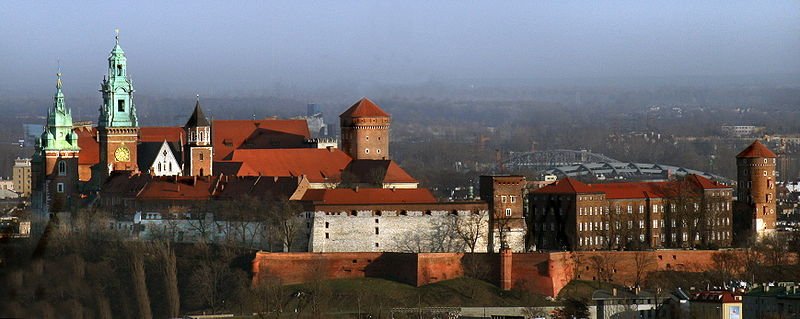 Kraków, Poland
Kraków, PolandSource: https://commons.wikimedia.org/wiki/File:Wawel_-_widok_z_Kopca_Ko%C5%9Bciuszki.jpg
Author: Arkadiusz Frankowicz

Kraków is the second largest city in Poland. It covers 327 sq km (126.3 sq mi) and has a population of 756,000 (2011 estimate) within a metropolitan area of 1.5 million people. It is also one of the oldest cities in Poland. Its old town is today a World Heritage Site entitled Cracow's Historic Centre.
Kraków is on the banks of the Vistula River. It is traditionally regarded as the academic, cultural and artistic nerve center of Poland, as well as being one of its economic hubs. It has numerous historic sights that today make it one of Poland's top tourist destinations.
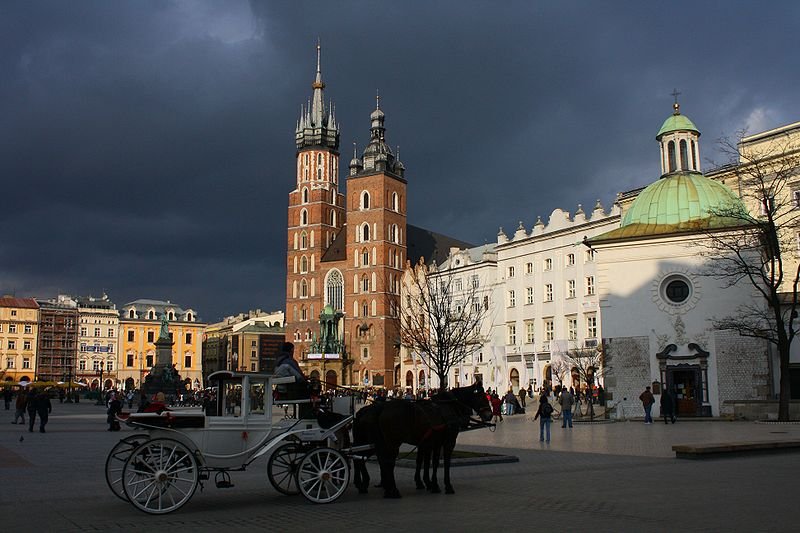 The Central Market Square of Kraków
The Central Market Square of KrakówSource: https://commons.wikimedia.org/wiki/File:Rynek_Glowny_w_Krakowie.jpg
Author: Ludwig Schneider

Kraków sits on the foot of the Carpathian Mountains, at an average elevation of 219 m (719 ft) above sea level. It is bounded by the Jurassic Rock Upland to the north and to the south, the Tatra Mountains, with forms the border between Poland with Slovakia and the Czech Republic.
Kraków is one of the easternmost cities in Europe to experience an oceanic climate. The warmest month here is July, when the average high temperature reaches 24.2°C (75.6°F). It is also the wettest month, receiving an average of 90 mm (3.54 in) of rain. Coldest month is January, with average low temperature of -2.1°C (28.2°F).
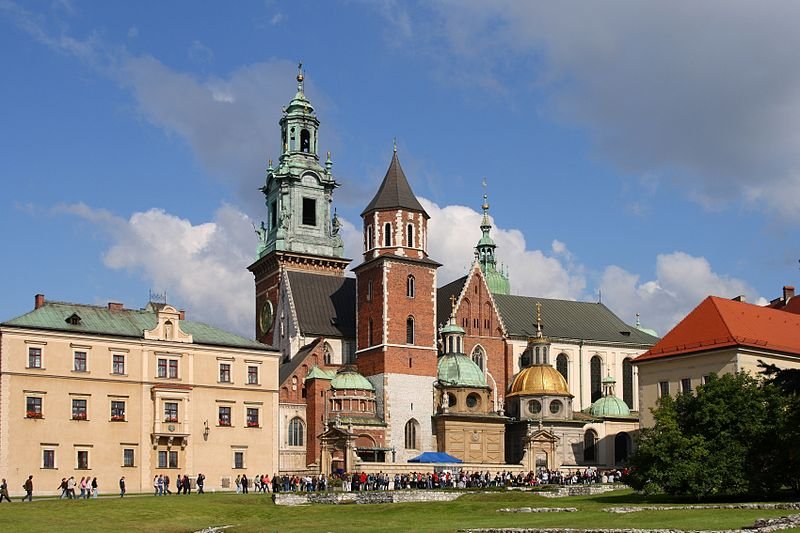 Cathedral of Saints Stanisław and Wacław at Wawel, Kraków
Cathedral of Saints Stanisław and Wacław at Wawel, KrakówSource: https://commons.wikimedia.org/wiki/File:Krak%C3%B3w_-_Wawel_Cathedral_01.jpg
Author: Lestat

The name Kraków, often written as Cracow, was named after its founder Krakus, a legendary Polish prince of the Lechitian tribe from the 12th century. Human habitation in the Kraków area however goes back much earlier, right into prehistory. A permanent settlement has been established in Kraków as early as the 7th century. Between 1038 and 1596 it served as the capital of Poland, while between 1846 and 1918, it was the capital of the Grand Duchy of Kraków.
With so much history on its back, Kraków is today one of the most beautiful cities in Europe, the handiwork of past artists and architects who have left their mark here. Kraków has the biggest number of historic buildings and monuments in Poland.
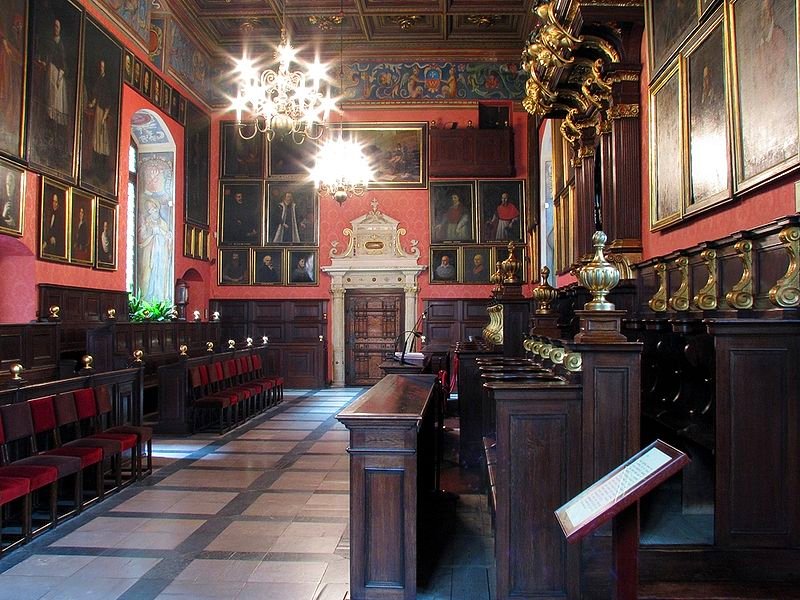 Aula Jagiellońska in Collegium Maius, Kraków
Aula Jagiellońska in Collegium Maius, KrakówSource: https://commons.wikimedia.org/wiki/File:Collegium_maius,_Aula_Jagiello%C5%84ska.jpg
Author: bazylek100

Visiting Kraków
The John Paul II International Airport (KRK) is the gateway to Kraków for most foreign visitors. Located in Balice, about 12 km west of downtown, it is the second biggest airport in Poland. Arriving here, you have the option of taking the train or the bus. The train connects the airport to the central railway station in Kraków. You can buy the train ticket from the attendant on board. The fare is 7 PLN for the 18-minute journey. Alternatively you can also take public buses 292 and 208 from the airport to downtown Kraków.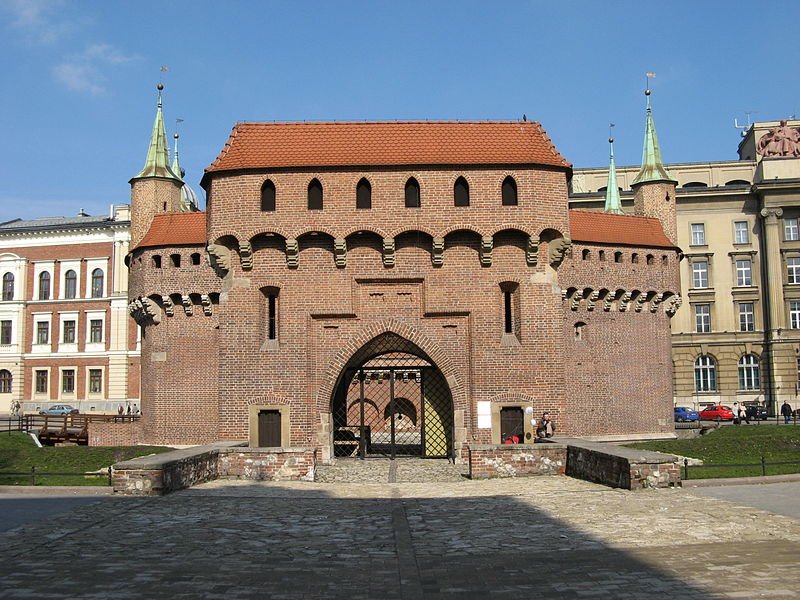 The Barbican in Kraków
The Barbican in KrakówSource: https://commons.wikimedia.org/wiki/File:Barbakan_Krakow_od_Bramy_Florianskiej.jpg
Author: Ludek

Sights & Attractions in Kraków
- Barbican
15th century Barbican, a remnant of Kraków's fortification, was built in 1498. - Benedictine Abbey in Tyniec
An abbey dating back to the 11th century. It sits on a limestone outcrop overlooking the Vistula River. The present buildings, in the Baroque style, dates to 1618-22. - Camaldolite Monastery in Bielany
A monastery on Srebrna Góra (Silver Mountain) built in the Mannerist-Baroque style. Its occupants are monks who commit themselves to absolute silence and maintain minimum contact with the outside world. - Cathedral of Saints Stanisław and Wacław
Located on the Wawel, this is one of the most important churches for Polish royalty. It was where Polish rulers were once crowned. There are also royal tombs for the rulers here. - Central Market Square (Rynek Główny)
The huge square in the middle of Kraków is certainly one of the largest in Europe. It is surrounded by many historic sights. - Church of Corpus Christi
This is a parish church for the town of Kazimierz, now part of Kraków. It was started in the 14th century. The interior has fine works of art in the Baroque style. - Church of St Anne (Kościół św. Anny)
An imposing Baroque-style church with two church towers built at the turn of the 18th century. - Church of St Mary (Kośsiół Mariaski)
The Church of St Mary, the most important church in Kraków, dates back to 1355, but construction continued into the mid-15th century. It faces the Central Market Square. - Church of St Wojciech
A small Romanesque chuch on the south side of the Central Market Square. - Church of Saints Peter and Paul (Kościół św. św. Piotra i Pawła)
This is one of the most beautiful early Baroque churches in Poland, built between 1596 and 1605. - Cistercian Abbey in Mogiła
Abbey founded in the 13th century. Its much older interior is encased by a Baroque façade completed in 1779-80. - Cloth Hall
Located right in the center of the Central Market Square, this beautiful Renaissance building replaces an earlier market hall in the Gothic style. - Collegium Maius
Oldest surviving college of the Javiellonian University. Established in 1364, it owes its present appearance to the restoration carried out in the 19th century. - Czartoryski Museum
A small museum with a fascinating collection of Polish art started in the 18th century. - Decjusz Villa
A manor house dating back to the late Middle Ages, this villa was rebuilt in the Renaissance style in 1530 by Justus Ludwik Decjusz. Its present appearance dates to 1620. - Dominican Church (Kośsiół Dominikanów)
The Dominican Church is an beautiful Gothic structure from the mid-15th century. - Franciscan Church
Started in the 13th century, with rebuilding carried out in the 17th and 19th centuries, the church bore elements from different periods, including Art Nouveau murals and stained-glass windows by Stanisśaw Wyspiański from the turn of the 20th century. - Józef Mehoffer Museum
A small museum celebrating the works of the famous Art Nouveau stained-glass artist. - Kraków City Hall Tower
A stand-alone tower, a remnant of the former city hall, located on the Central Market Square. It was built in the Gothic style. - Medical Society Building (Gmach Towarzystwa Lekarskiego)
Historic building completed in 1904 featuring fantastic interior decor from furnishings to its beautiful stained-glass window. - Old Synagogue
Built in the mid-16th century to replace an earlier one that burned down, it houses today a museum of the Jews in Kraków and their persecution under the Nazis. - National Museum of Kraków
A mammoth building that was started in the 1930s and only completed in 1989, it houses exhibits on applied arts, militaria, historical artifacts as well as fine arts. - Pauline Church on the Rock (Kościół Paulinów na Skałce)
Baroque-style church built in 1733-42 by Gerhard Müntzer and Antoni Solari. - Piarist Church (Kościół Pijarów)
A beautiful church with a Rococo façade built in the 18th century. - Plac Matejki
A square laid out in the 19th century with the Church of St Florian (Kościół św. Floriana) at one corner. - Plac Szczepański
A busy square surrounded by a number of sights including the Old Theater (Teatr Stary), the Palace of Fine Arts (Pałac Sztuki) and a 1960s Brutalist-style building called The Bunker (Bunkier). - Premonstratensian Church (Kościół Norbertanek)
This is a church and convent by the bank of the Vistula River. The church dates to its rebuilding in 1604. Among the sights here is the octagonal Chapel of St Margaret (Kaplica św Małgorzaty) in the early Baroque style. - Remuh Cemetery and Synagogue
This is one of the two Jewish synagogues in Kraków that are still in use. It dates back to 1557. Behind it is one of the most important Jewish cemeteries in Europe, with graves dating back to the 16th century. - Stanisław Wyspiański Museum
Museum showcasing the works of the brilliant stained-glass artist who also does art with textile and pastels. - Ulica Floriańska
A lively street in Kraków today lined with cafés and restaurants. At one end of it is the Florian Gate, part of the city's medieval wall. - Ulica Grodzka
A winding, picturesque street leading out from the Central Market Square. Among trhe sights here include the Collegium Iuridicum (a 15th century law college), the Church of St Andrew (Kościół św. Andrzeja) and the Church of St Martin (Kościół św. Marcina). - Ulica Kanonicza
Named after the canons of KrakówChapterhouse, this street is lined with houses dating from the Middle Ages, and rebuilt over the centuries, to show elements of Renaissance, Baroque and Neo-Classical styles. Among the sights here include the Archdiocesan Museum and the Ukrainian Art Gallery. - Ulica Retoryka
Street lined by the flamboyant houses designed by 19th century architect Teodor Talowski. - Wawel
A limestone outcrop on the lest bank of Vistula River in Kraków that has a number of historic sights including the citadel, the Cathedral of Saints Stanisław and Wacław, and the Royal Castle. Also within the complex is the Cathedral Museum and the "Lost Wawel" Exhibit.
 Latest updates on Penang Travel Tips
Latest updates on Penang Travel Tips
 Discover with Timothy YouTube Channel
Discover with Timothy YouTube Channel
 PG Food Channel
PG Food Channel
 Learn Penang Hokkien YouTube Channel
Learn Penang Hokkien YouTube Channel
 SojiMart Videos
SojiMart Videos
Latest from Discover with Timothy: Gurney Bay - what to see and do there
About this website

Hello and thanks for reading this page. My name is Timothy and my hobby is in describing places so that I can share the information with the general public. My website has become the go to site for a lot of people including students, teachers, journalists, etc. whenever they seek information on places, particularly those in Malaysia and Singapore. I have been doing this since 5 January 2003, for over twenty years already. You can read about me at Discover Timothy. By now I have compiled information on thousands of places, mostly in Peninsular Malaysia and Singapore, and I continue to add more almost every day. My goal is to describe every street in every town in Malaysia and Singapore.
Robbie's Roadmap
- Episode 1: Robbie's Journey to Financial Freedom
- Episode 2: Lost in America
- Episode 3: The Value of Money
- Episode 4: The Mentor
- Episode 5: The Thing that Makes Money
- Episode 6: The walk with a Billionaire
- Episode 7: The Financial Freedom Awakening
- Episode 8: Meet Mr Washington
- Episode 9: The Pizzeria Incident
Copyright © 2003-2024 Timothy Tye. All Rights Reserved.


 Go Back
Go Back